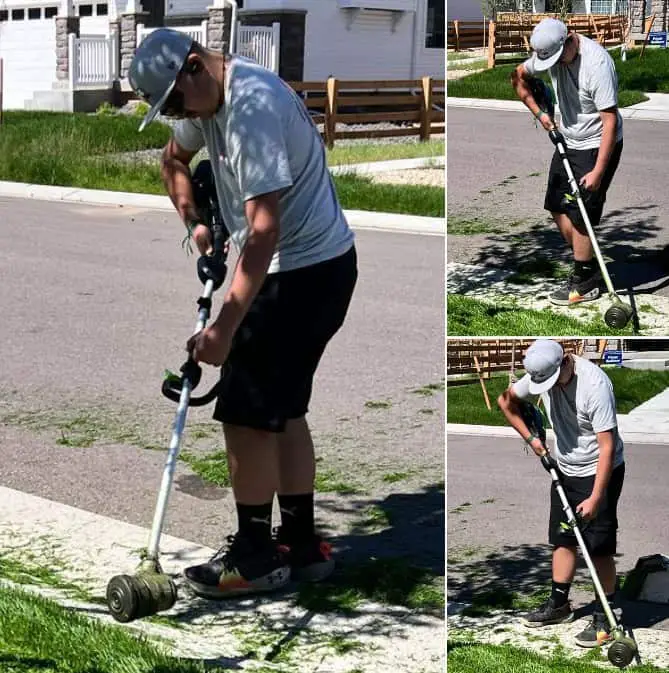Have a nice day!
Ever wondered why landscapers remove the guard from their string trimmers? I’ve pondered on this too, and after tireless research, I’ve found that it’s more than just personal preference.
This article will breakdown the reasons behind it – from increased cutting areas to improved trimming accuracy, all while addressing safety concerns. Intrigued yet? Well then, let’s dive deeper into this green thumb mystery!
Contents
Key Takeaways
- Landscapers remove the guard from string trimmers to have a longer string, which increases the cutting area and improves efficiency.
- Taking off the guard also enhances sight for more accurate trimming, allowing landscapers to contour their cuts better to the natural shape of the lawn.
- However, removing the guard is not recommended due to safety hazards like flying debris and potential contact with the spinning line, as well as long-term damage to the trimmer itself. Safety should always be a top priority when operating any power tool.
Why Do Landscapers Take The Guard Off String Trimmers?
Landscapers take the guard off string trimmers to have a longer string for increased cutting area and improved sight for more accurate trimming.
Read more: How Long Do Gas String Trimmers Last?
Longer string for increased cutting area
I’ve come across a good number of landscapers who opt to remove the guard from their string trimmers. The most common reason behind this practice is that it allows them to use a longer string.
Now, you may wonder why anyone would need a long line for trimming and here’s why: it dramatically increases the cutting area! This means fewer movements and less time spent on each spot, leading to boosted efficiency.
It’s true – by simply extending your trimmer’s reach, you can cut down larger areas of grass in one go. So next time when you see me without a guard on my tool, know that I’m not just being reckless – I’m actually trying to get the job done faster and better.
Improved sight for accurate trimming
Taking the guard off string trimmers significantly improves visibility during operation. As an experienced landscape professional, I’ve found that this enhanced sight allows for more precise and meticulous trimming.
Being able to clearly see where you’re cutting reduces mistakes and can lead to a neater, more polished lawn appearance overall.
It’s like removing blinders; without the obstruction of a guard, it becomes easier to contour your trimming to the terrain and natural shape of your lawn. However, though this may appear as an appealing advantage in terms of efficiency and aesthetic results; safety precautions should always be at the forefront before making modifications like these on any equipment including string trimmers.
Should I remove guard from string trimmer?
Removing the guard from a string trimmer is not recommended due to potential safety hazards, increased risk of debris flying around, and possible long-term damage to the trimmer itself.
Read more: Why Does My String Trimmer Line Keep Getting Stuck?

Potential safety hazards for the operator
I’d like to bring to your attention the potential safety risks you’re exposing yourself to as a lawn owner, when removing the guard from your string trimmer.
- The first risk you’d encounter is flying debris. From small pebbles to bits of grass, anything can be hurled with high velocity in any direction without the guard.
- Next, comes the threat of direct contact with the string itself. Without a guard, it’s quite possible for your hands or legs to accidentally come into contact with the rapidly spinning nylon line which can easily result in cuts and injuries.
- Lack of control over line length is another hazard. The guard helps keep this under control reducing strain on the engine, but without it, you risk damaging your equipment.
- Finally, remember there are usually two guards installed on trimmers – front and rear ones.While front guards protect against flying debris, rear ones are there to protect your feet from accidental contact with the string.
Increased risk of debris flying around
Removing the guard from a string trimmer significantly increases the risk of debris flying around. Without the guard in place, there is no barrier to slow down or control the momentum of debris as it’s being cut.
This means that grass clippings, rocks, and other objects can potentially be propelled towards you, bystanders, or nearby objects with greater force and distance. It’s essential to remember that safety should always be a top priority when operating any power tool.
Potential long-term damage to the trimmer
Removing the guard from a string trimmer may seem like a tempting idea for some landscapers, but it can potentially lead to long-term damage to the trimmer. When the guard is taken off, the engine becomes more exposed and vulnerable.
This increases the risk of debris getting inside and causing damage, which could result in costly repairs or even render the trimmer unusable. Additionally, running a string trimmer without a guard can cause excessive vibrations that may harm internal components over time.
It’s essential to prioritize the longevity of your equipment by keeping the guard intact and ensuring proper maintenance to avoid any potential long-term damage to your trusty tool.

Conclusion
In conclusion, while some landscapers choose to remove the guard from their string trimmers for increased productivity and control, it is not recommended due to potential safety hazards, risks of debris flying around, and long-term damage to the trimmer.
The guard serves a crucial purpose in regulating string release and protecting both the operator and surrounding areas. It’s essential to prioritize safety and follow manufacturer guidelines when operating any equipment.
FAQs
What is a flower guard on a trimmer?
A flower guard, also known as a trimmer guard, is a protective covering that is installed on string trimmers to serve multiple purposes. Its primary function is to control the length of the cutting line while preventing debris like grass clippings, rocks, and other objects from being thrown around during trimming.
This guard ensures that the operator remains safe by minimizing the risk of injuries caused by flying debris. It plays an important role in maintaining a clean and tidy work area while protecting delicate flowers and plants from accidental damage.
Are string trimmers bad for grass?
String trimmers, when used correctly and with the appropriate guard in place, are not inherently bad for grass. In fact, they can be a valuable tool for maintaining a neat and well-manicured lawn.
However, problems can arise if the trimmer is used without its guard or if it comes into direct contact with the turf.
Without the protective guard, string trimmers have the potential to damage grass by cutting too closely to the ground. This can result in scalping, which weakens the turf and leaves it vulnerable to pests, diseases, and weed infestations.
Additionally, running a trimmer without a guard increases the risk of debris flying around and causing harm to nearby plants or structures.
That’s why it’s crucial to prioritize safety by always using a string trimmer with its guard intact. The guard acts as a shield between the string and your lawn, preventing excessive cutting depth and protecting both your grass and surrounding landscape elements like trees or shrubs.
What is the difference between edge trimmer and string trimmer?
As a lawn owner, it’s important to understand the difference between an edge trimmer and a string trimmer. An edge trimmer is specifically designed to create perfect edges in your yard, while a string trimmer is used for trimming weeds or grass that may have been missed by your lawnmower.
The main distinction lies in their functions: an edger focuses on creating clean borders, while a string trimmer tackles those hard-to-reach areas and keeps your yard looking professionally landscaped.
Both tools have spinning blades and guards but serve different purposes when it comes to maintaining the overall appearance of your lawn. So, depending on your specific needs, you can choose between an edger or a string trimmer to achieve the desired results for your yard.





